Abstract
The multiple acyl-coenzyme A (CoA) dehydrogenation disorders (MAD) include severe (S) and mild (M) variants, glutaric aciduria type II (MAD:S) and ethylmalonic-adipic aciduria (MAD:M). Intact MAD:M mitochondria oxidized [1-14C]octanoate, [1-14C]palmityl-CoA, and [1,5-14C]glutarate at 20-46% of control levels; MAD:S mitochondria oxidized these three substrates at 0.4-18% of control levels. In MAD:M mitochondria, acyl-CoA dehydrogenase (ADH) activities were similar to control, whereas MAD:S ADH activities ranged from 38% to 73% of control. Electron transfer flavoprotein (ETF) activities in five MAD:M cell lines ranged from 29 to 51% of control (P less than 0.01); ETF deficiency was the primary enzymatic defect in two MAD:M lines. In four MAD:S patients, ETF activities ranged from 3% to 6% of control (P less than 0.001); flavin adenine dinucleotide addition increased residual ETF activity from 4% to 21% of control in a single MAD:S line (P less than 0.01). Three MAD:S patients had ETF activities ranging from 33 to 53% of control; other investigators found deficient ETF-dehydrogenase activity in these MAD:S and three of our MAD:M cell lines.
Full text
PDF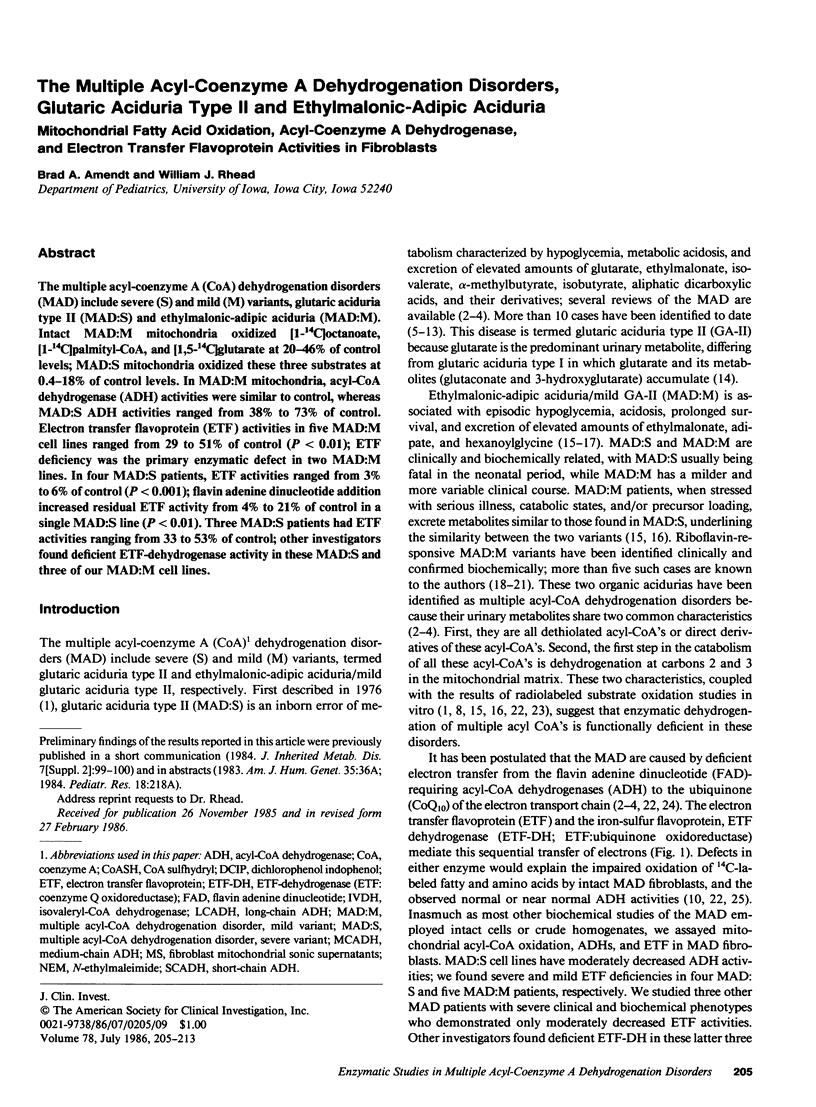
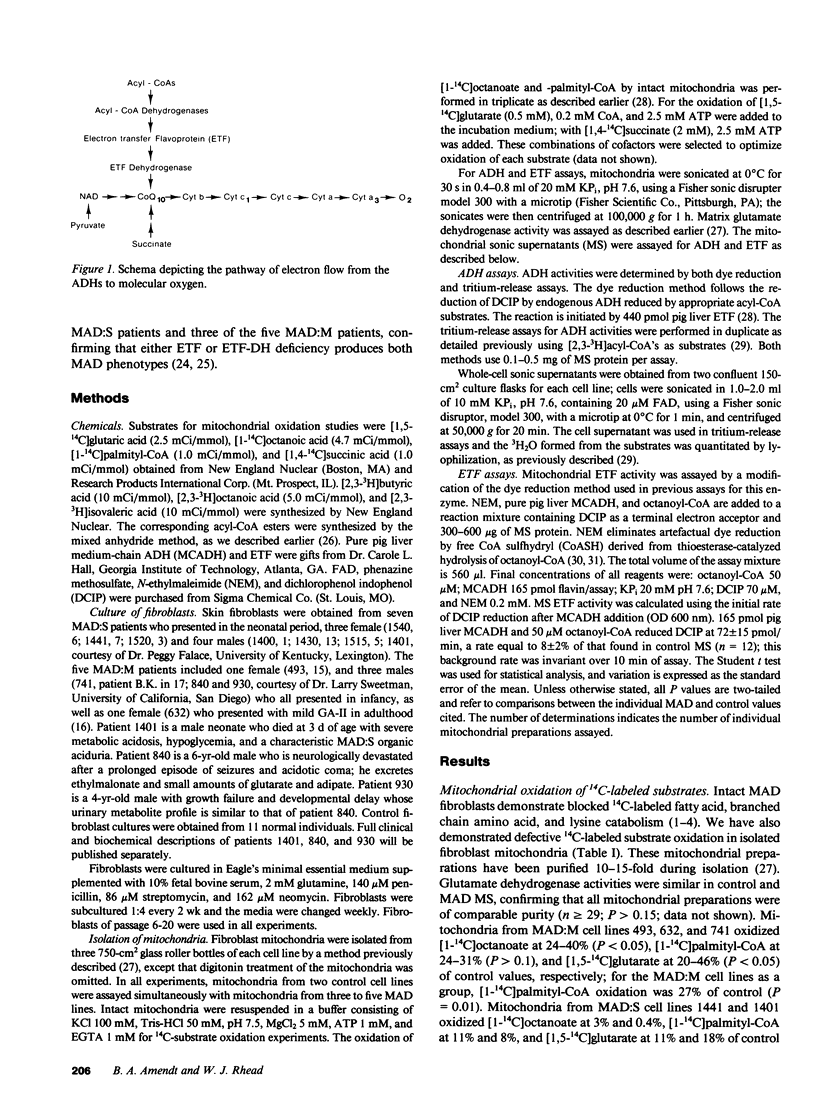
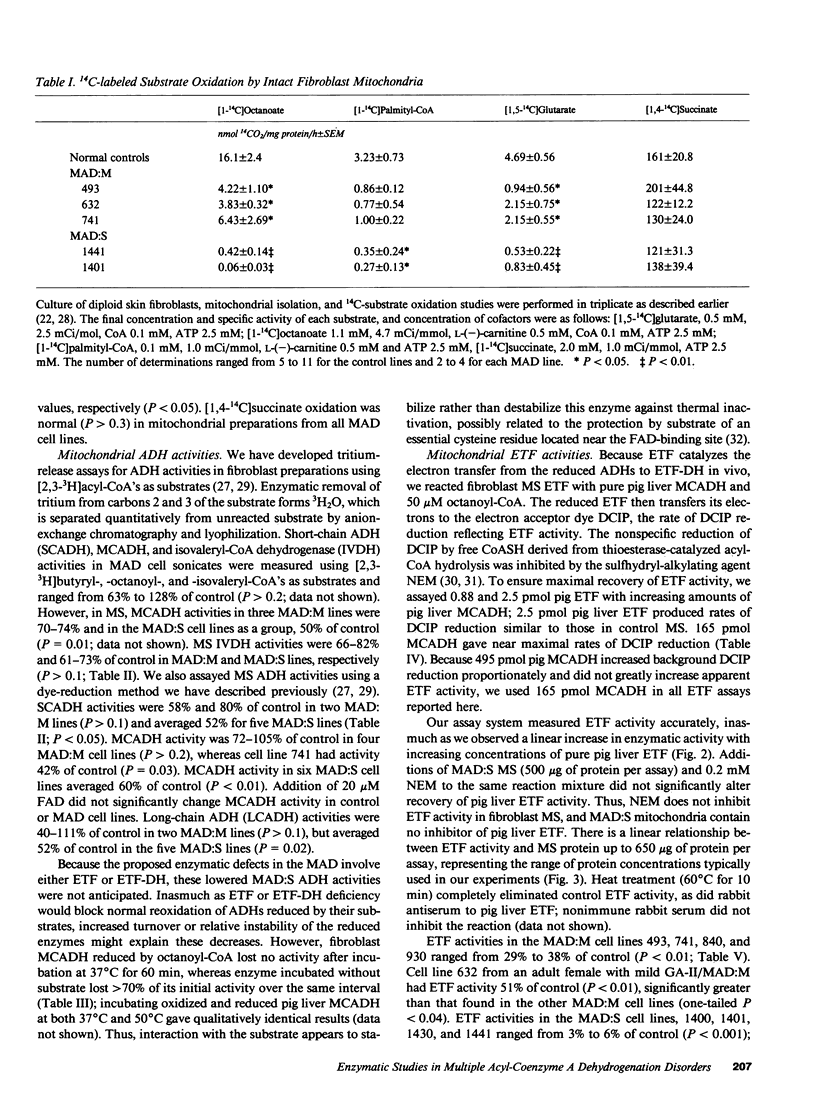
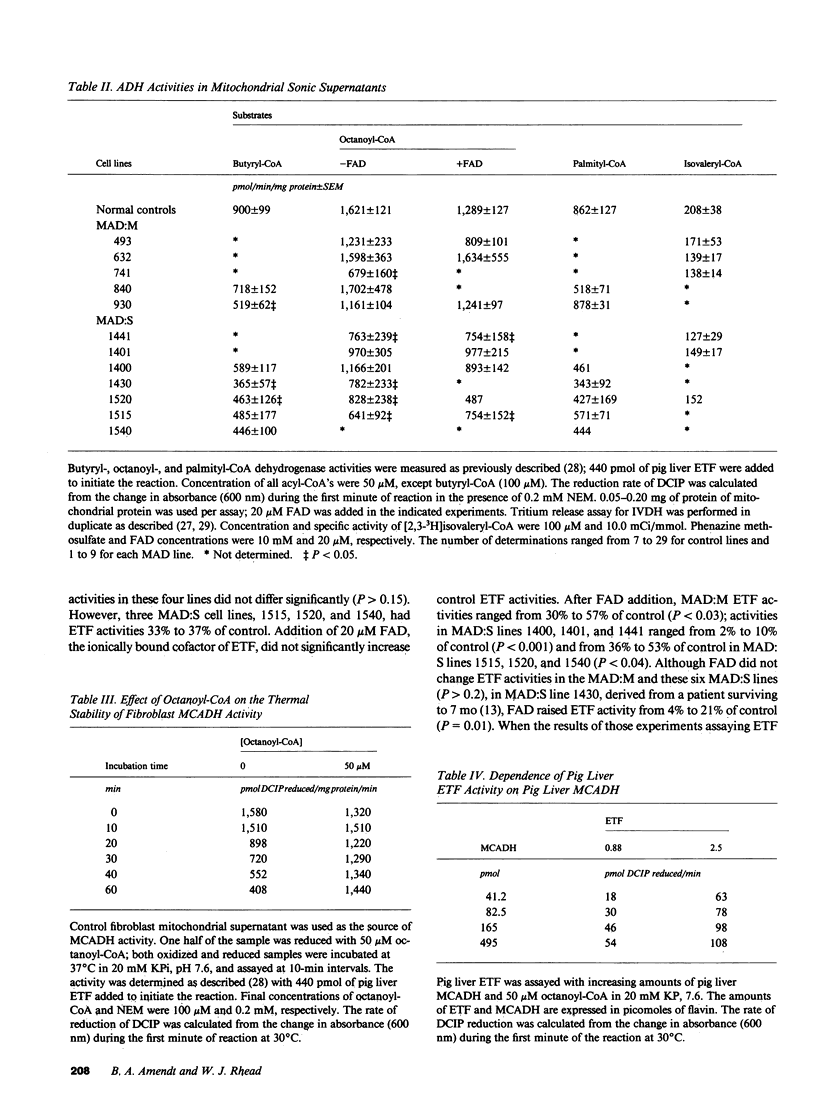
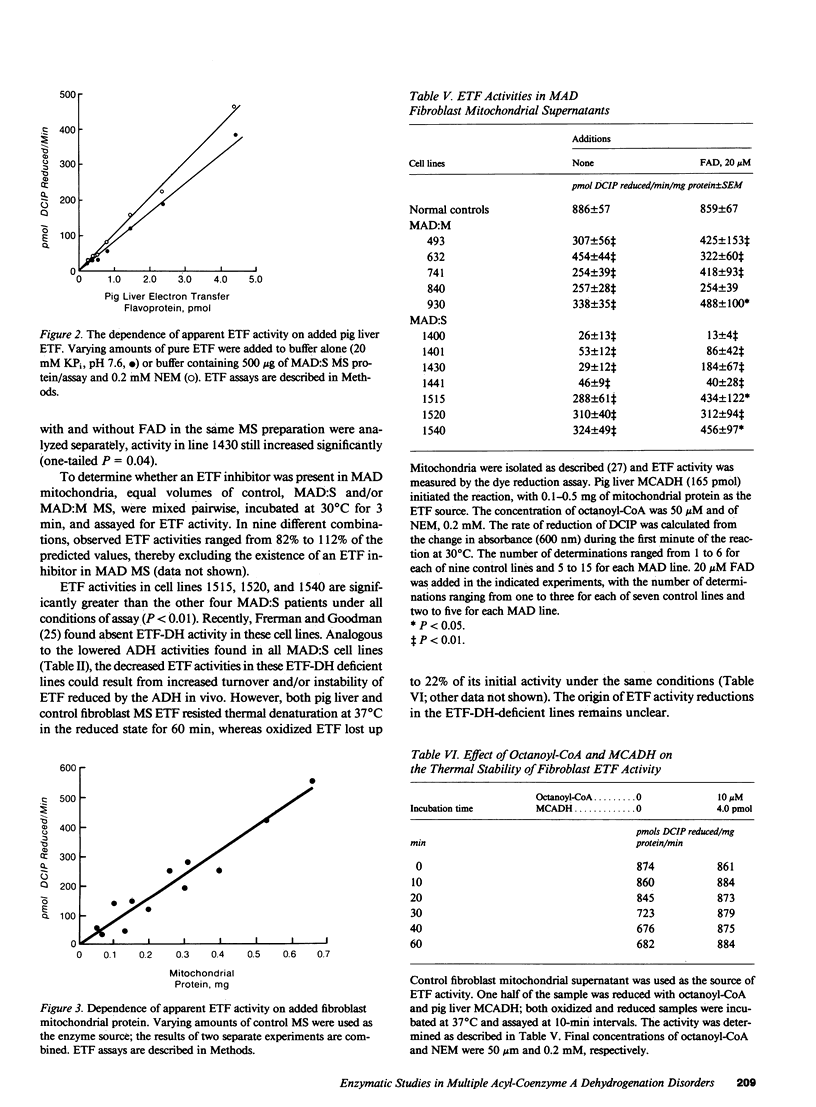
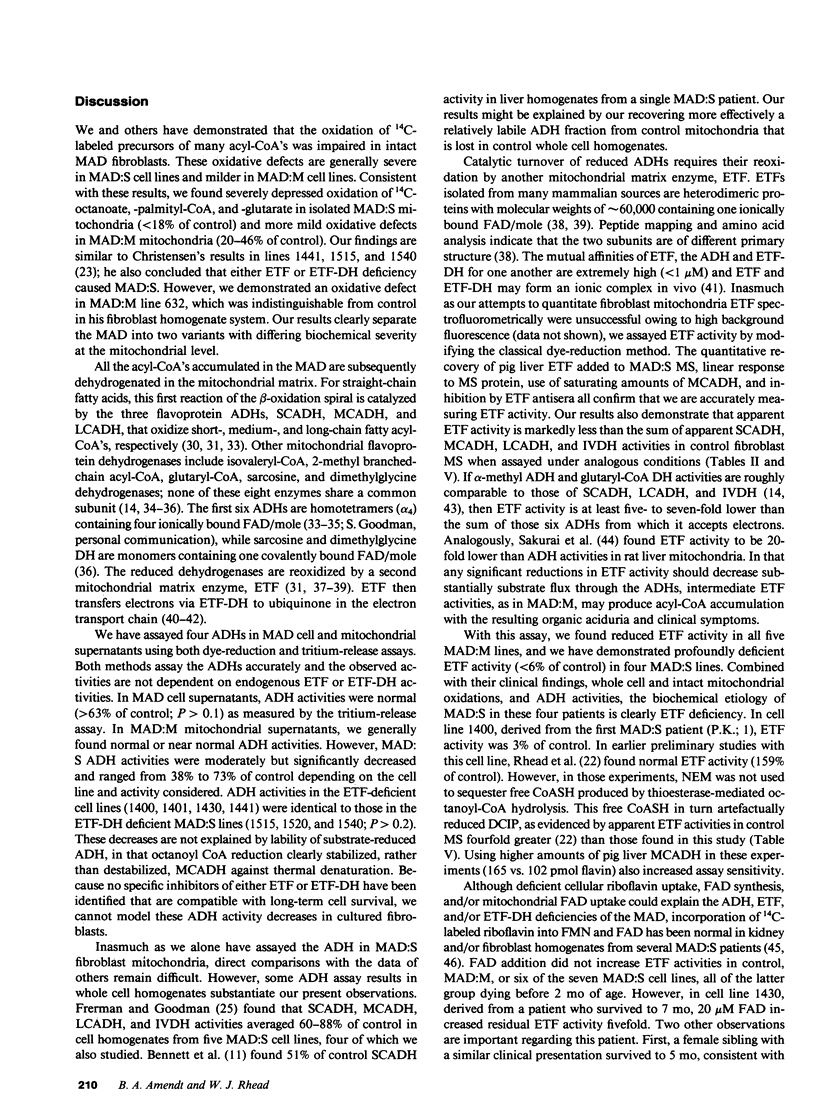
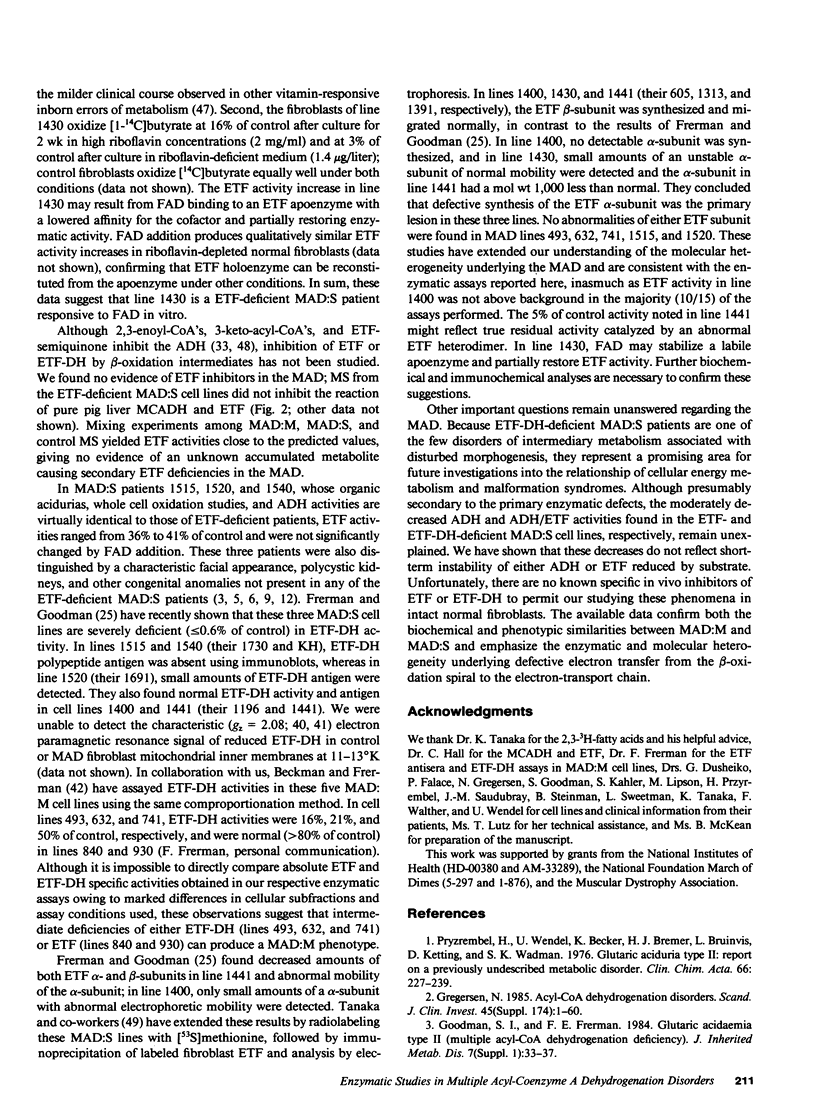
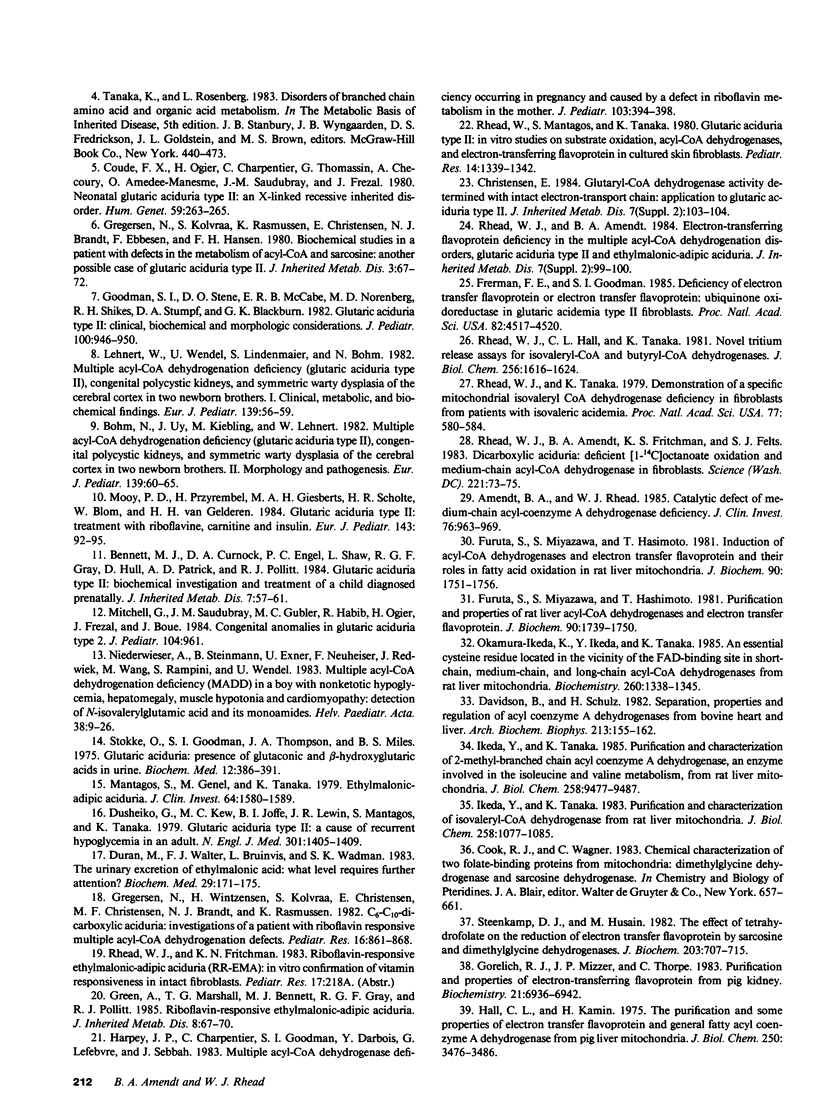
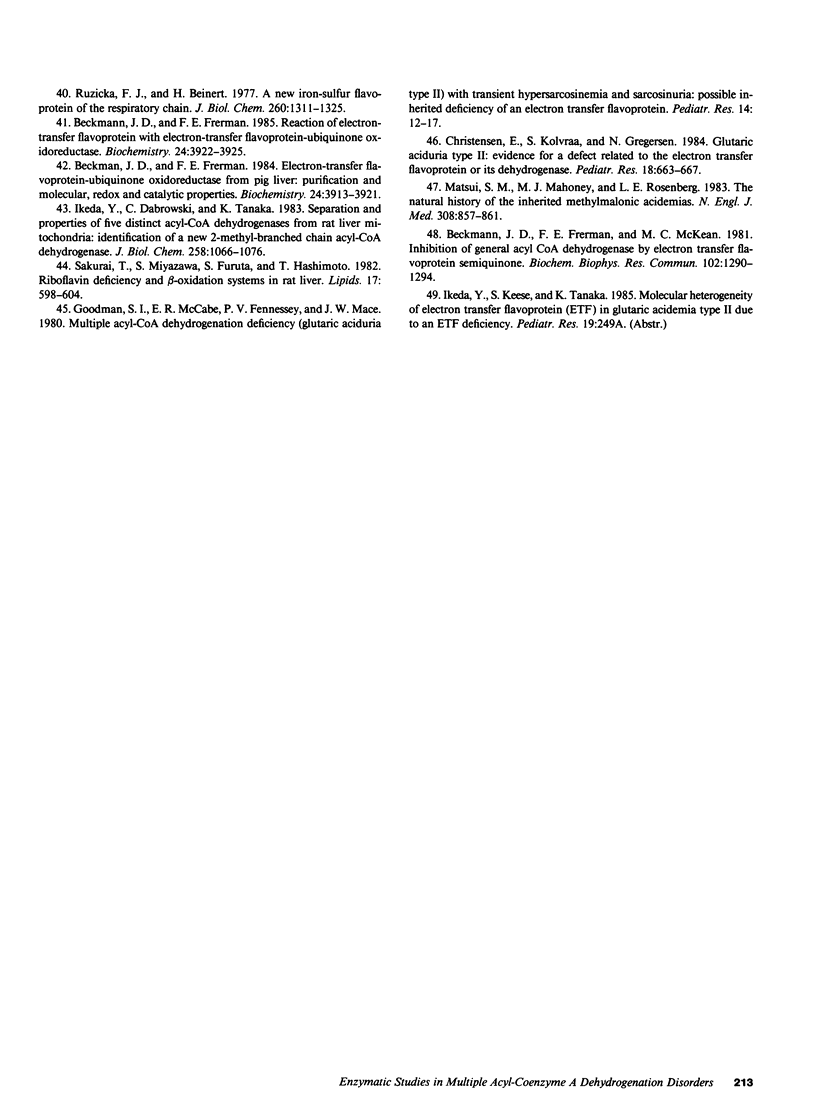
Selected References
These references are in PubMed. This may not be the complete list of references from this article.
- Amendt B. A., Rhead W. J. Catalytic defect of medium-chain acyl-coenzyme A dehydrogenase deficiency. Lack of both cofactor responsiveness and biochemical heterogeneity in eight patients. J Clin Invest. 1985 Sep;76(3):963–969. doi: 10.1172/JCI112096. [DOI] [PMC free article] [PubMed] [Google Scholar]
- Beckmann J. D., Frerman F. E. Electron-transfer flavoprotein-ubiquinone oxidoreductase from pig liver: purification and molecular, redox, and catalytic properties. Biochemistry. 1985 Jul 16;24(15):3913–3921. doi: 10.1021/bi00336a016. [DOI] [PubMed] [Google Scholar]
- Beckmann J. D., Frerman F. E., McKean M. C. Inhibition of general acyl CoA dehydrogenase by electron transfer flavoprotein semiquinone. Biochem Biophys Res Commun. 1981 Oct 30;102(4):1290–1294. doi: 10.1016/s0006-291x(81)80151-9. [DOI] [PubMed] [Google Scholar]
- Beckmann J. D., Frerman F. E. Reaction of electron-transfer flavoprotein with electron-transfer flavoprotein-ubiquinone oxidoreductase. Biochemistry. 1985 Jul 16;24(15):3922–3925. doi: 10.1021/bi00336a017. [DOI] [PubMed] [Google Scholar]
- Bennett M. J., Curnock D. A., Engel P. C., Shaw L., Gray R. G., Hull D., Patrick A. D., Pollitt R. J. Glutaric aciduria type II: biochemical investigation and treatment of a child diagnosed prenatally. J Inherit Metab Dis. 1984;7(2):57–61. doi: 10.1007/BF01805802. [DOI] [PubMed] [Google Scholar]
- Böhm N., Uy J., Kiessling M., Lehnert W. Multiple acyl-CoA dehydrogenation deficiency (glutaric aciduria type II), congenital polycystic kidneys, and symmetric warty dysplasia of the cerebral cortex in two newborn brothers. II. Morphology and pathogenesis. Eur J Pediatr. 1982 Sep;139(1):60–65. doi: 10.1007/BF00442082. [DOI] [PubMed] [Google Scholar]
- Christensen E. Glutaryl-CoA dehydrogenase activity determined with intact electron-transport chain: application to glutaric aciduria type II. J Inherit Metab Dis. 1984;7 (Suppl 2):103–104. doi: 10.1007/978-94-009-5612-4_26. [DOI] [PubMed] [Google Scholar]
- Christensen E., Kølvraa S., Gregersen N. Glutaric aciduria type II: evidence for a defect related to the electron transfer flavoprotein or its dehydrogenase. Pediatr Res. 1984 Jul;18(7):663–667. doi: 10.1203/00006450-198407000-00020. [DOI] [PubMed] [Google Scholar]
- Coude F. X., Ogier H., Charpentier C., Thomassin G., Checoury A., Amedee-Manesme O., Saudubray J. M., Frezal J. Neonatal glutaric aciduria type II: an X-linked recessive inherited disorder. Hum Genet. 1981;59(3):263–265. doi: 10.1007/BF00283677. [DOI] [PubMed] [Google Scholar]
- Davidson B., Schulz H. Separation, properties, and regulation of acyl coenzyme A dehydrogenases from bovine heat and liver. Arch Biochem Biophys. 1982 Jan;213(1):155–162. doi: 10.1016/0003-9861(82)90450-7. [DOI] [PubMed] [Google Scholar]
- Duran M., Walther F. J., Bruinvis L., Wadman S. K. The urinary excretion of ethylmalonic acid: what level requires further attention? Biochem Med. 1983 Apr;29(2):171–175. doi: 10.1016/0006-2944(83)90037-6. [DOI] [PubMed] [Google Scholar]
- Dusheiko G., Kew M. C., Joffe B. I., Lewin J. R., Mantagos S., Tanaka K. Recurrent hypoglycemia associated with glutaric aciduria type II in an adult. N Engl J Med. 1979 Dec 27;301(26):1405–1409. doi: 10.1056/NEJM197912273012601. [DOI] [PubMed] [Google Scholar]
- Frerman F. E., Goodman S. I. Deficiency of electron transfer flavoprotein or electron transfer flavoprotein:ubiquinone oxidoreductase in glutaric acidemia type II fibroblasts. Proc Natl Acad Sci U S A. 1985 Jul;82(13):4517–4520. doi: 10.1073/pnas.82.13.4517. [DOI] [PMC free article] [PubMed] [Google Scholar]
- Furuta S., Miyazawa S., Hashimoto T. Induction of acyl-CoA dehydrogenases and electron transfer flavoprotein and their roles in fatty acid oxidation in rat liver mitochondria. J Biochem. 1981 Dec;90(6):1751–1756. doi: 10.1093/oxfordjournals.jbchem.a133652. [DOI] [PubMed] [Google Scholar]
- Furuta S., Miyazawa S., Hashimoto T. Purification and properties of rat liver acyl-CoA dehydrogenases and electron transfer flavoprotein. J Biochem. 1981 Dec;90(6):1739–1750. doi: 10.1093/oxfordjournals.jbchem.a133651. [DOI] [PubMed] [Google Scholar]
- Goodman S. I., Frerman F. E. Glutaric acidaemia type II (multiple acyl-CoA dehydrogenation deficiency). J Inherit Metab Dis. 1984;7 (Suppl 1):33–37. doi: 10.1007/BF03047371. [DOI] [PubMed] [Google Scholar]
- Goodman S. I., McCabe E. R., Fennessey P. V., Mace J. W. Multiple acyl-CoA dehydrogenase deficiency (glutaric aciduria type II) with transient hypersarcosinemia and sarcosinuria; possible inherited deficiency of an electron transfer flavoprotein. Pediatr Res. 1980 Jan;14(1):12–17. doi: 10.1203/00006450-198001000-00004. [DOI] [PubMed] [Google Scholar]
- Goodman S. I., Stene D. O., McCabe E. R., Norenberg M. D., Shikes R. H., Stumpf D. A., Blackburn G. K. Glutaric acidemia type II: clinical, biochemical, and morphologic considerations. J Pediatr. 1982 Jun;100(6):946–950. doi: 10.1016/s0022-3476(82)80525-8. [DOI] [PubMed] [Google Scholar]
- Gorelick R. J., Mizzer J. P., Thorpe C. Purification and properties of electron-transferring flavoprotein from pig kidney. Biochemistry. 1982 Dec 21;21(26):6936–6942. doi: 10.1021/bi00269a049. [DOI] [PubMed] [Google Scholar]
- Green A., Marshall T. G., Bennett M. J., Gray R. G., Pollitt R. J. Riboflavin-responsive ethylmalonic-adipic aciduria. J Inherit Metab Dis. 1985;8(2):67–70. doi: 10.1007/BF01801667. [DOI] [PubMed] [Google Scholar]
- Gregersen N., Kølvraa S., Rasmussen K., Christensen E., Brandt N. J., Ebbesen F., Hansen F. H. Biochemical studies in a patient with defects in the metabolism of acyl-CoA and sarcosine: another possible case of glutaric aciduria type II. J Inherit Metab Dis. 1980;3(3):67–72. doi: 10.1007/BF02312527. [DOI] [PubMed] [Google Scholar]
- Gregersen N. The acyl-CoA dehydrogenation deficiencies. Recent advances in the enzymic characterization and understanding of the metabolic and pathophysiological disturbances in patients with acyl-CoA dehydrogenation deficiencies. Scand J Clin Lab Invest Suppl. 1985;174:1–60. [PubMed] [Google Scholar]
- Gregersen N., Wintzensen H., Christensen S. K., Christensen M. F., Brandt N. J., Rasmussen K. C6-C10-dicarboxylic aciduria: investigations of a patient with riboflavin responsive multiple acyl-CoA dehydrogenation defects. Pediatr Res. 1982 Oct;16(10):861–868. doi: 10.1203/00006450-198210000-00012. [DOI] [PubMed] [Google Scholar]
- Hall C. L., Kamin H. The purification and some properties of electron transfer flavoprotein and general fatty acyl coenzyme A dehydrogenase from pig liver mitochondria. J Biol Chem. 1975 May 10;250(9):3476–3486. [PubMed] [Google Scholar]
- Harpey J. P., Charpentier C., Goodman S. I., Darbois Y., Lefèbvre G., Sebbah J. Multiple acyl-CoA dehydrogenase deficiency occurring in pregnancy and caused by a defect in riboflavin metabolism in the mother. Study of a kindred with seven deaths in infancy: Value of riboflavin therapy in preventing this syndrome. J Pediatr. 1983 Sep;103(3):394–398. doi: 10.1016/s0022-3476(83)80410-7. [DOI] [PubMed] [Google Scholar]
- Ikeda Y., Dabrowski C., Tanaka K. Separation and properties of five distinct acyl-CoA dehydrogenases from rat liver mitochondria. Identification of a new 2-methyl branched chain acyl-CoA dehydrogenase. J Biol Chem. 1983 Jan 25;258(2):1066–1076. [PubMed] [Google Scholar]
- Ikeda Y., Tanaka K. Purification and characterization of 2-methyl-branched chain acyl coenzyme A dehydrogenase, an enzyme involved in the isoleucine and valine metabolism, from rat liver mitochondria. J Biol Chem. 1983 Aug 10;258(15):9477–9487. [PubMed] [Google Scholar]
- Ikeda Y., Tanaka K. Purification and characterization of isovaleryl coenzyme A dehydrogenase from rat liver mitochondria. J Biol Chem. 1983 Jan 25;258(2):1077–1085. [PubMed] [Google Scholar]
- Lehnert W., Wendel U., Lindenmaier S., Böhm N. Multiple acyl-CoA dehydrogenation deficiency (glutaric aciduria type II), congenital polycystic kidneys, and symmetric warty dysplasia of the cerebral cortex in two brothers. I. Clinical, metabolical, and biochemical findings. Eur J Pediatr. 1982 Sep;139(1):56–59. doi: 10.1007/BF00442081. [DOI] [PubMed] [Google Scholar]
- Mantagos S., Genel M., Tanaka K. Ethylmalonic-adipic aciduria. In vivo and in vitro studies indicating deficiency of activities of multiple acyl-CoA dehydrogenases. J Clin Invest. 1979 Dec;64(6):1580–1589. doi: 10.1172/JCI109619. [DOI] [PMC free article] [PubMed] [Google Scholar]
- Matsui S. M., Mahoney M. J., Rosenberg L. E. The natural history of the inherited methylmalonic acidemias. N Engl J Med. 1983 Apr 14;308(15):857–861. doi: 10.1056/NEJM198304143081501. [DOI] [PubMed] [Google Scholar]
- Mitchell G., Saudubray J. M., Gubler M. C., Habib R., Ogier H., Frezal J., Boue J. Congenital anomalies in glutaric aciduria type 2. J Pediatr. 1984 Jun;104(6):961–962. doi: 10.1016/s0022-3476(84)80520-x. [DOI] [PubMed] [Google Scholar]
- Mooy P. D., Przyrembel H., Giesberts M. A., Scholte H. R., Blom W., van Gelderen H. H. Glutaric aciduria type II: treatment with riboflavine, carnitine and insulin. Eur J Pediatr. 1984 Dec;143(2):92–95. doi: 10.1007/BF00445792. [DOI] [PubMed] [Google Scholar]
- Niederwieser A., Steinmann B., Exner U., Neuheiser F., Redweik U., Wang M., Rampini S., Wendel U. Multiple acyl-Co A dehydrogenation deficiency (MADD) in a boy with nonketotic hypoglycemia, hepatomegaly, muscle hypotonia and cardiomyopathy. Detection of N-isovalerylglutamic acid and its monoamide. Helv Paediatr Acta. 1983 Mar;38(1):9–26. [PubMed] [Google Scholar]
- Okamura-Ikeda K., Ikeda Y., Tanaka K. An essential cysteine residue located in the vicinity of the FAD-binding site in short-chain, medium-chain, and long-chain acyl-CoA dehydrogenases from rat liver mitochondria. J Biol Chem. 1985 Jan 25;260(2):1338–1345. [PubMed] [Google Scholar]
- Przyrembel H., Wendel U., Becker K., Bremer H. J., Bruinvis L., Ketting D., Wadman S. K. Glutaric aciduria type II: report on a previously undescribed metabolic disorder. Clin Chim Acta. 1976 Jan 16;66(2):227–239. doi: 10.1016/0009-8981(76)90060-7. [DOI] [PubMed] [Google Scholar]
- Rhead W. J., Amendt B. A. Electron-transferring flavoprotein deficiency in the multiple acyl-CoA dehydrogenation disorders, glutaric aciduria type II and ethylmalonic--adipic aciduria. J Inherit Metab Dis. 1984;7 (Suppl 2):99–100. doi: 10.1007/978-94-009-5612-4_24. [DOI] [PubMed] [Google Scholar]
- Rhead W. J., Amendt B. A., Fritchman K. S., Felts S. J. Dicarboxylic aciduria: deficient [1-14C]octanoate oxidation and medium-chain acyl-CoA dehydrogenase in fibroblasts. Science. 1983 Jul 1;221(4605):73–75. doi: 10.1126/science.6857268. [DOI] [PubMed] [Google Scholar]
- Rhead W. J., Hall C. L., Tanaka K. Novel tritium release assays for isovaleryl-CoA and butyryl-CoA dehydrogenases. J Biol Chem. 1981 Feb 25;256(4):1616–1624. [PubMed] [Google Scholar]
- Rhead W. J., Tanaka K. Demonstration of a specific mitochondrial isovaleryl-CoA dehydrogenase deficiency in fibroblasts from patients with isovaleric acidemia. Proc Natl Acad Sci U S A. 1980 Jan;77(1):580–583. doi: 10.1073/pnas.77.1.580. [DOI] [PMC free article] [PubMed] [Google Scholar]
- Rhead W., Mantagos S., Tanaka K. Glutaric aciduria type II: in vitro studies on substrate oxidation, acyl-CoA dehydrogenases, and electron-transferring flavoprotein in cultured skin fibroblasts. Pediatr Res. 1980 Dec;14(12):1339–1342. doi: 10.1203/00006450-198012000-00013. [DOI] [PubMed] [Google Scholar]
- Sakurai T., Miyazawa S., Furuta S., Hashimoto T. Riboflavin deficiency and beta-oxidation systems in rat liver. Lipids. 1982 Sep;17(9):598–604. doi: 10.1007/BF02535365. [DOI] [PubMed] [Google Scholar]
- Steenkamp D. J., Husain M. The effect of tetrahydrofolate on the reduction of electron transfer flavoprotein by sarcosine and dimethylglycine dehydrogenases. Biochem J. 1982 Jun 1;203(3):707–715. doi: 10.1042/bj2030707. [DOI] [PMC free article] [PubMed] [Google Scholar]
- Stokke O., Goodman S. I., Thompson J. A., Miles B. S. Glutaric aciduria; presence of glutaconic and beta-hydroxyglutaric acids in urine. Biochem Med. 1975 Apr;12(4):386–391. doi: 10.1016/0006-2944(75)90071-x. [DOI] [PubMed] [Google Scholar]


